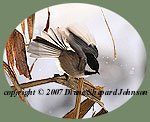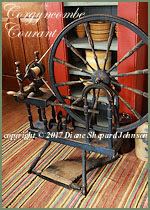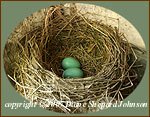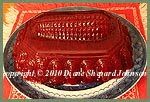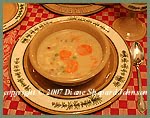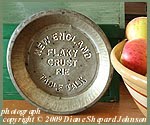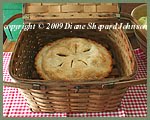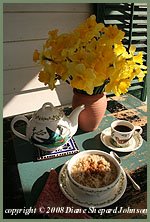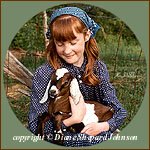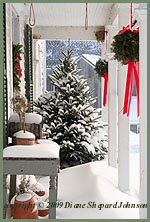Corgyncombe Library Notes
 When Diane was a little girl, she used to go over to her neighbor Ginny's to play in her playhouse. Diane decided that she had to have a playhouse of her own! She took her Daddy by the hand to see Ginny's playhouse. Diane's Daddy soon set about the task of making her a playhouse. Diane insisted that her little house must have a chimney. In the above picture Diane is pretending she is a bride. As you can see in the photograph, there is already a wash hanging on the line.
When Diane was a little girl, she used to go over to her neighbor Ginny's to play in her playhouse. Diane decided that she had to have a playhouse of her own! She took her Daddy by the hand to see Ginny's playhouse. Diane's Daddy soon set about the task of making her a playhouse. Diane insisted that her little house must have a chimney. In the above picture Diane is pretending she is a bride. As you can see in the photograph, there is already a wash hanging on the line.
 Diane is pretending she is a bride.
Diane is pretending she is a bride.
 Diane's playhouse had a kitchen, a nursery, and a parlour. Diane's Daddy used to come in and have lunch with her. Diane delighted in all the flowers that were around and about her cottage. The view from the kitchen window looked up the hill where there was a white picket fence with pink and red climbing roses. Behind the playhouse there was another picket fence with an arbor that also had climbing roses. Pink and white peonies grew going down the hill past her Mum's clothes line. Diane's father picked Diane a bouquet of the peonies and she told him she would someday use this bouquet when she married him. The sunflowers were on the edge of Diane's father's huge vegetable garden. When Diane was growing up her family had goats, sheep, chickens, ducks, and rabbits. The barn for the animals was across the lawn and through the lilac hedge.
Diane's playhouse had a kitchen, a nursery, and a parlour. Diane's Daddy used to come in and have lunch with her. Diane delighted in all the flowers that were around and about her cottage. The view from the kitchen window looked up the hill where there was a white picket fence with pink and red climbing roses. Behind the playhouse there was another picket fence with an arbor that also had climbing roses. Pink and white peonies grew going down the hill past her Mum's clothes line. Diane's father picked Diane a bouquet of the peonies and she told him she would someday use this bouquet when she married him. The sunflowers were on the edge of Diane's father's huge vegetable garden. When Diane was growing up her family had goats, sheep, chickens, ducks, and rabbits. The barn for the animals was across the lawn and through the lilac hedge.
 Diane's doll Bonnie with Gertrude Jekyll's book "Children & Gardens".
Diane's doll Bonnie with Gertrude Jekyll's book "Children & Gardens".
In Gertrude Jekyll's book "Children & Gardens", the chapter "Gardens and Play-House" caught the eye of The Corgyncombe Courant. Gertrude talks about gardening around and about the playhouse. Gertrude describes quite an elaborate playhouse where the children would keep house, bake, cook, and entertain, as well as tend a garden. Besides a kitchen the playhouse she describes has a pantry and a parlour for tea parties. Gertrude gives receipts for various soups, a salad, scrambled eggs, scones, and fairy cakes. The receipts use things grown in the playhouse garden. She recommends herbs to grow in the small cottage garden to use for cooking in the playhouse kitchen.
This reminds us of Darling and Domestic Daisy who lives at Corgyncombe Cottage and loves to bake and cook and care for her Baby Doll.
Here is a link to: Daisy preparing for a tea party.
Here is a link to: Daisy hosting a tea party.
In the book "Children & Gardens", Gertrude wrote: "There are thousands of little girls in England, and small boys too, who would not only delight in working the play-house but who would in after years visit it again with delight and look back on its lessons of play-work with thankfulness, both for joyful memories and for the abiding usefulness of all that it had taught them."
At the end of the chapter Gertrude wrote: "In the play-house pantry, or better still, in the summer weather somewhere near but out-of-doors, we wash the dollies' clothes. If the sun is very hot we put on our sun-bonnets, and we pin ourselves up in bath-towels so that no splash matters, and turn up our sleeves as high as they will go, and have out that nice red pan and wash all their things. Cotton, muslin and flannel; little frocks and petticoats and shimmies, and their tiny pocket-handkerchiefs, and hang them on the line to dry." There is a sweet little photograph of two little girls wearing sunbonnets and pinned "up in bath-towels so that no splash matters" hanging up their dollies' wash.
 When Diane was older she helped her father build a small greenhouse near the lilacs and peonies.
When Diane was older she helped her father build a small greenhouse near the lilacs and peonies.Diane has always loved gardening!
~~~~~~~~~~~~~~~~~~~~~~~~~~~~~~~~~
 Yesterday was a beautiful day for afternoon spinning in the garden at Corgyncombe Cottage. How peaceful it was with the birds singing, the butterflies flitting and fluttering about, and Corgi Creek babbling in the background.
Yesterday was a beautiful day for afternoon spinning in the garden at Corgyncombe Cottage. How peaceful it was with the birds singing, the butterflies flitting and fluttering about, and Corgi Creek babbling in the background. Diane's Kromski Spinning Wheel.
Diane's Kromski Spinning Wheel. Butterflies in the garden remind The Corgyncombe Courant of Beatrix Potter's "The Tale of Tom Kitten". As Mother Cat Tabitha was expecting company she had dressed her three kittens up in fine clothes. More preparations needed to be completed before her guests arrived so she let her kittens go out in the garden but warned them to be careful not to soil their clothing. There is an illustration of Tom Kitten dressed in a darling blue suit and straw hat amusing himself with a butterfly as it flits about the garden.
Butterflies in the garden remind The Corgyncombe Courant of Beatrix Potter's "The Tale of Tom Kitten". As Mother Cat Tabitha was expecting company she had dressed her three kittens up in fine clothes. More preparations needed to be completed before her guests arrived so she let her kittens go out in the garden but warned them to be careful not to soil their clothing. There is an illustration of Tom Kitten dressed in a darling blue suit and straw hat amusing himself with a butterfly as it flits about the garden. As eveningtide approached the moon was lovely in the sky o'er the Corgyncombe gardens. The butterflies of day were replaced by the fireflies of twilight. Delightful sparkles all about the garden!!!
As eveningtide approached the moon was lovely in the sky o'er the Corgyncombe gardens. The butterflies of day were replaced by the fireflies of twilight. Delightful sparkles all about the garden!!!
